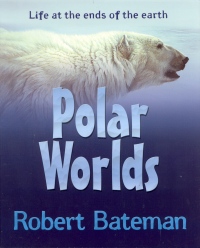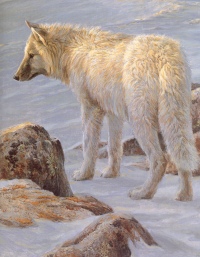| ________________
CM . . .
. Volume XV Number 6. . . .November 7, 2008 
 |
Polar Worlds: Life at the Ends of the Earth.
Robert Bateman with Nancy Kovacs.
Toronto, ON: Scholastic Canada/Madison Press, 2008.
48 pp., hardcover, $19.99.
ISBN 978-0-545-99725-6.
Subject Headings:
Animals-Polar regions-Juvenile literature.
Animals-Polar regions-Pictorial works-Juvenile literature.
Bateman, Robert, 1930- -Travel-Polar regions-Juvenile literature.
Polar regions-Description and travel-Juvenile literature.
Grade 3- 7 / Ages 8-12.
Review by Gregory Bryan.
***½ /4
|
| |
|

excerpt:
Animals in the Arctic and Antarctica have been over-hunted by humans. Some are killed by industrial fishing. Global warming is changing the balance of the climate. Ice caps are shrinking, threatening the animals that depend on that ice as part of their life cycle. In the past, the whales of Antarctica were saved from extinction by human effort. Now, some longline fisheries color their bait blue to prevent albatrosses and other sea animals from eating it. Otherwise, they might get caught in the nets and drown. Other solutions can be found if we continue to work at it. We just need to try.
Following on from the success of his beautifully illustrated nature books for children, Backyard Birds and Birds of Prey, Robert Bateman's latest informational picture book for children is another sure winner. Polar Worlds: Life at the Ends of the Earth will please readers young and old.
 Bateman is recognized as one of the world's finest nature artists. The exquisite paintings and sketches in Polar Worlds reflect the same incomparable quality that we have come to expect from Bateman. In Polar Worlds, Bateman turns his attention to the wildlife eking out an existence in the challenging frozen landscapes of the world's Polar Regions, the Arctic and Antarctica. Bateman is recognized as one of the world's finest nature artists. The exquisite paintings and sketches in Polar Worlds reflect the same incomparable quality that we have come to expect from Bateman. In Polar Worlds, Bateman turns his attention to the wildlife eking out an existence in the challenging frozen landscapes of the world's Polar Regions, the Arctic and Antarctica.
In Polar Worlds, Bateman's great talent is best reflected in about 20 different full colour and full-page paintings (some paintings are almost full page while some are greater than full page). There are also a number of other smaller, but very detailed, paintings and monochromatic sketches. Bateman's paintings are stunningly realistic. The cover image of the polar bear is breathtaking in detail and texture. Bateman has a marvelous eye for detail, and with the heavily textures paintings, one gets a sense of being able to reach out and touch the various bears, whales, birds and seals that appear in the book. One of my favourite illustrations is the inside cover double page image that captures the vast, silent expanses that are the domain of the powerful polar bear. Another favourite is the painting of the pair of Tundra Swans with their baby cygnets. The painting suggests a regal serenity that one cannot help but admire. Such images are consistent with what I perceive to be a main theme of the book—the need to carefully manage and protect the vulnerable, fragile ecosystems of the far north and far south. Throughout the text, Bateman sprinkles several warnings about the detrimental impact that humans can have on the environment. On page 37, for instance, Bateman discusses longline fishing. He says, "More than three hundred thousand seabirds are killed by them each year." He also says that, despite, its relatively recent origins, longline fishing has already pushed albatrosses to the edge of extinction.
Polar Worlds is 48-pages in length. The final page contains a glossary of 15 terms, including such things as "circumpolar," "glacier," "ice flow" and "tundra." The book focuses on a variety of well-known and lesser-known polar creatures, ranging from well-known birds and animals such as polar bears, walruses, puffins and penguins, through to less well-known creatures like jaegers, murres and ermines. Many pages contain additional text "fact boxes," containing easily accessible, interesting extra information about the birds and animals discussed in the main text.
I enjoy the voice that comes through in Bateman's text. His personality comes through in the writing. In some ways, I also find that Bateman's individual voice helps me to more fully appreciate and understand his subject. Although the book has an informational text, Bateman does not employ a dry or sterile, impartial voice. Rather, as with the following extract, he places himself in the heart of the text.
"I once came upon a herd of Dall Sheep in an Alaska Park. Knowing that they can be very shy of people, I crept along carefully, circling around so that I could look down on them. I was feeling quite pleased with just how close I had come when one of them nonchalantly got up and came within a few feet of me. I'd had no idea they could be so tame."
We with an interest in literature for children recognize our good fortune in having an artist as talented, and highly regarded, as Robert Bateman illustrating books for children. Whether the reader is already familiar with Bateman's work or is new to his art, there is little doubt that readers young and old will appreciate this book.
Highly Recommended.
Gregory Bryan lives in Winnipeg where he teaches children's literature at the University of Manitoba.

To comment
on this title or this review, send mail to cm@umanitoba.ca.
Copyright © the Manitoba Library Association. Reproduction for personal
use is permitted only if this copyright notice is maintained. Any
other reproduction is prohibited without permission.
NEXT REVIEW |
TABLE OF CONTENTS FOR THIS ISSUE
- November 7, 2008.
AUTHORS |
TITLES |
MEDIA REVIEWS |
PROFILES |
BACK ISSUES |
SEARCH |
CMARCHIVE |
HOME |

 Bateman is recognized as one of the world's finest nature artists. The exquisite paintings and sketches in Polar Worlds reflect the same incomparable quality that we have come to expect from Bateman. In Polar Worlds, Bateman turns his attention to the wildlife eking out an existence in the challenging frozen landscapes of the world's Polar Regions, the Arctic and Antarctica.
Bateman is recognized as one of the world's finest nature artists. The exquisite paintings and sketches in Polar Worlds reflect the same incomparable quality that we have come to expect from Bateman. In Polar Worlds, Bateman turns his attention to the wildlife eking out an existence in the challenging frozen landscapes of the world's Polar Regions, the Arctic and Antarctica.